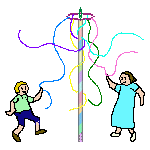
May Day (May 1st) has long been associated with spring festivals and coincides with the ancient Celtic celebration of Beltane (the name being derived from the Celtic sun god Belenus.) It has, however, in recent years developed a second association as a day of celebration for the Labour Movement and now, with a socialist government in power, the Monday nearest to May 1st been accorded the status of May Day Bank Holiday - a statutory “day off” for most workers, thus bringing it into line with centuries-old tradition!
May 1st is also the feast of St. Walburga, an eighth-century English nun who lived and worked as a missionary in Germany. There, the the night before her feast day is celebrated as Walpurgis Night, with its overtones of witchcraft, exactly six months before Hallowe'en, the pagan night before another Christian holy day, All Saint's Day.
THE ORIGINS OF THE FESTIVAL
Beltane is one of the ancient pre-Christian fire festivals (along with midsummer, Hallowe'en and midwinter - now translated into Christmas.)
It was actually a three-day festival which ended on May 1st with general festivities and merrymaking. The focus of the rites was to ensure fertility for the coming year - the maypole is a rather obvious fertility symbol - and young couples would sleep outdoors to celebrate the "Great Rite" (hm!) a practice which, not surprisingly, was finally made illegal in 1644 by the Puritan government.
Bonfires were an important part of the rites - livestock would be driven between two fires on their way to their summer pasture, to drive out evil spirits and avoid bad luck - and the daytime dancing would be continued into the night around the fires, and if you could jump over the fires (preferably naked) you would be protected against bad luck and diseases. Young couples would also jump over the fire to show their intention to marry or "handfast" at the coming Midsummer festival.

CUSTOMS AND TRADITIONS
Maypole Dancing is the great tradition of May 1st. A Maypole is a permanent feature of many English villages - some are very old and others are recent replacemants, a tribute to the traditions of the past. On May Day, teams of dancers will perform intricate patterns whilst circling the pole and the ribbons will interweave as they make their way down the pole with a very decorative result.
Crowning the May Queen is another old tradition which persists. Originally there would have been a May King as well as a May Queen (back to those fertility rites again...) but now it is more customary for the May Queen to be a teenage girl, with child attendants or "May Princesses." In some places the May King/May Queen tradition is associated with Robin Hood and Maid Marian, popular figures in English folklore dating from the period just after the Norman Conquest.
There are several local customs which take place on May Day, such as the Padstow Obby Oss, and the 1st of May is sometimes marked by Morris Dancing.
"Here we go gathering nuts in May..." always puzzled me as a child. NUTS - in MAY?? Quite ridiculous. There is, of course, a simple explanation. It was originally "knots of May" - a reference to the custom of gathering flowers as part of the celebrations, particularly May blossom, the flower of the Hawthorn (Crataegus monogyna) which usually comes into blossom around the end of April. This custom of "Maying" was (and is some places still is) very widespread - fortunately the Hawthorn is a very common shrub and a distinctive feature of the English countryside.
May Day, like midsummer, is supposed to be an excellent time to see fairies.

For some photos of modern Maypole dancing, click here (US page) and here (UK), and there is another nice page all about May Day here.